关于澳大利亚的英文介绍
- 格式:rtf
- 大小:14.76 KB
- 文档页数:7
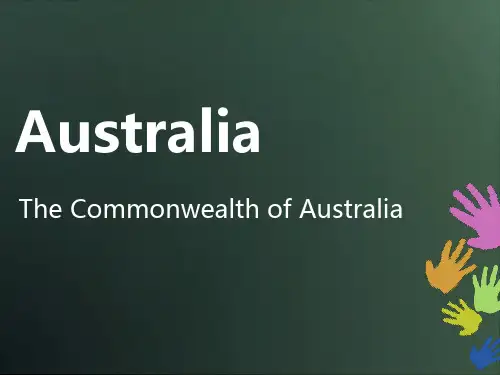
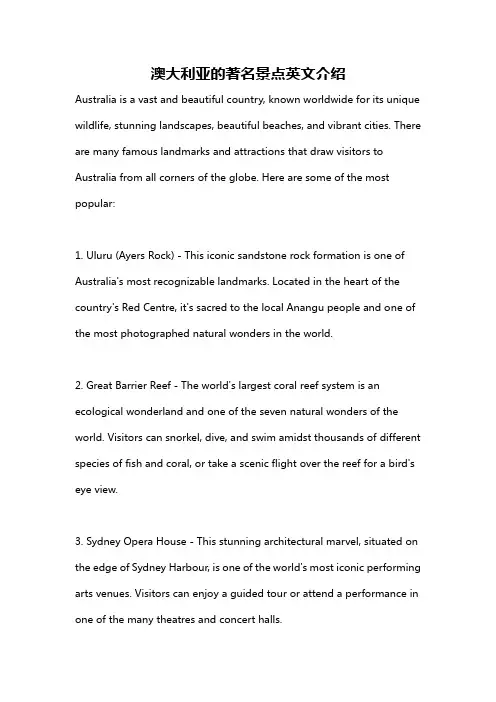
澳大利亚的著名景点英文介绍Australia is a vast and beautiful country, known worldwide for its unique wildlife, stunning landscapes, beautiful beaches, and vibrant cities. There are many famous landmarks and attractions that draw visitors to Australia from all corners of the globe. Here are some of the most popular:1. Uluru (Ayers Rock) - This iconic sandstone rock formation is one of Australia's most recognizable landmarks. Located in the heart of the country's Red Centre, it's sacred to the local Anangu people and one of the most photographed natural wonders in the world.2. Great Barrier Reef - The world's largest coral reef system is an ecological wonderland and one of the seven natural wonders of the world. Visitors can snorkel, dive, and swim amidst thousands of different species of fish and coral, or take a scenic flight over the reef for a bird's eye view.3. Sydney Opera House - This stunning architectural marvel, situated on the edge of Sydney Harbour, is one of the world's most iconic performing arts venues. Visitors can enjoy a guided tour or attend a performance in one of the many theatres and concert halls.4. Great Ocean Road -This scenic coastal drive winds along Victoria's south-western coastline, showcasing breathtaking views of rugged cliffs, offshore islands, and iconic landmarks like the Twelve Apostles rock formations.5. Kakadu National Park - This vast wilderness area is famous for its incredible natural beauty, Aboriginal rock art sites, and diverse range of flora and fauna.6. Bondi Beach - This world-famous beach, located just a short distance from Sydney's city center, is a hot spot for surfers, sun-seekers, and beach lovers from all over the world.7. The Whitsunday Islands - This group of 74 islands located in the heart of the Great Barrier Reef boasts some of the world's most beautiful, untouched beaches, and crystal-clear waters perfect for snorkeling and diving.8. The Australian Outback - This rugged and remote region, with its vast deserts and unique landscapes, is home to the famous Uluru, as well as many other unique natural wonders and charming outback towns.9. The Blue Mountains - This stunning mountain range, just a short distance from Sydney, is famous for its dramatic scenery, ancient rock formations, and beautiful bushwalking trails.10. Tasmania - This island state, located off the south coast of Australia, boasts some of the country's most stunning and untouched wilderness areas, historic towns, and beautiful national parks.。

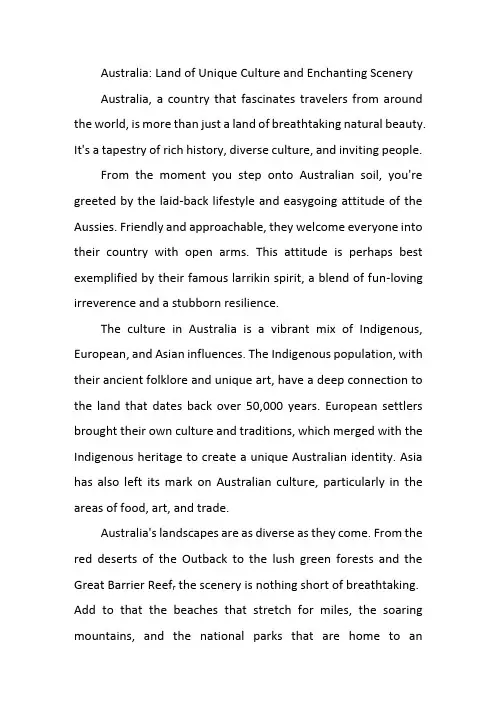
Australia: Land of Unique Culture and Enchanting SceneryAustralia, a country that fascinates travelers from around the world, is more than just a land of breathtaking natural beauty. It's a tapestry of rich history, diverse culture, and inviting people.From the moment you step onto Australian soil, you're greeted by the laid-back lifestyle and easygoing attitude of the Aussies. Friendly and approachable, they welcome everyone into their country with open arms. This attitude is perhaps best exemplified by their famous larrikin spirit, a blend of fun-loving irreverence and a stubborn resilience.The culture in Australia is a vibrant mix of Indigenous, European, and Asian influences. The Indigenous population, with their ancient folklore and unique art, have a deep connection to the land that dates back over 50,000 years. European settlers brought their own culture and traditions, which merged with the Indigenous heritage to create a unique Australian identity. Asia has also left its mark on Australian culture, particularly in the areas of food, art, and trade.Australia's landscapes are as diverse as they come. From the red deserts of the Outback to the lush green forests and the Great Barrier Reef r the scenery is nothing short of breathtaking. Add to that the beaches that stretch for miles, the soaring mountains, and the national parks that are home to anabundance of wildlife, and you have a country that is a nature lover's paradise.The cuisine in Australia is just as diverse as its people. From the iconic Australian barbecue to the rich and hearty bush tucker of the Indigenous Australians, there's something for every palate. European settlers have left their mark with dishes like Viennese coffee and Italian pizza, while Asian immigrants have introduced spicy Malaysian satays and fragrant Indian curries.Sports are an integral part of Australian culture. Australians are passionate about their sports teams, whether it's Aussie Rules Football, cricket, or horse racing. And let's not forget about the iconic Olympic Games where Australians have consistently punched above their weight, bringing home medals in a range of sports.So if you're looking for a destination that will captivate your senses with its natural beauty, rich history, and vibrant culture, then look no further than Australia. It's a country that will welcome you with open arms and make you feel right at home.。
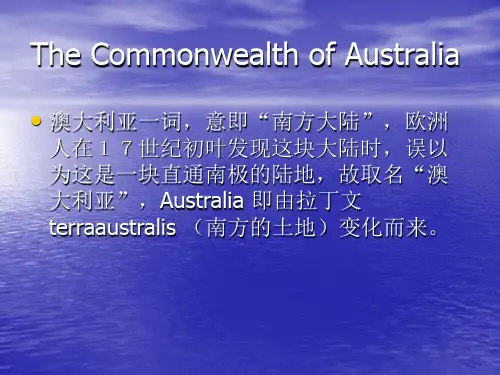
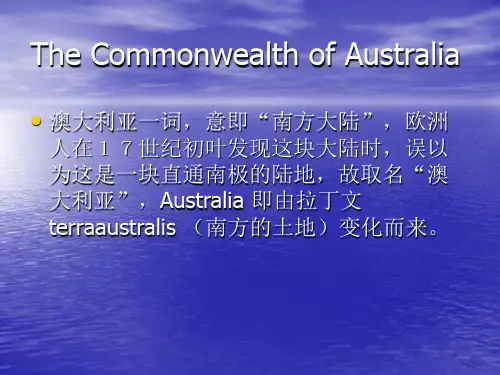
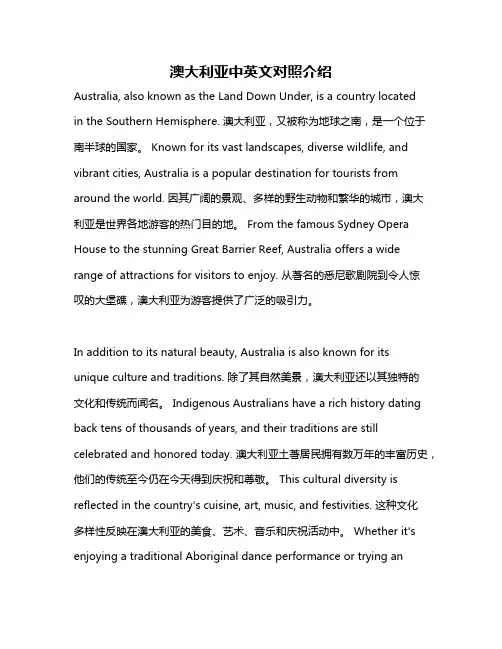
澳大利亚中英文对照介绍Australia, also known as the Land Down Under, is a country locatedin the Southern Hemisphere. 澳大利亚,又被称为地球之南,是一个位于南半球的国家。
Known for its vast landscapes, diverse wildlife, and vibrant cities, Australia is a popular destination for tourists from around the world. 因其广阔的景观、多样的野生动物和繁华的城市,澳大利亚是世界各地游客的热门目的地。
From the famous Sydney Opera House to the stunning Great Barrier Reef, Australia offers a wide range of attractions for visitors to enjoy. 从著名的悉尼歌剧院到令人惊叹的大堡礁,澳大利亚为游客提供了广泛的吸引力。
In addition to its natural beauty, Australia is also known for its unique culture and traditions. 除了其自然美景,澳大利亚还以其独特的文化和传统而闻名。
Indigenous Australians have a rich history dating back tens of thousands of years, and their traditions are still celebrated and honored today. 澳大利亚土著居民拥有数万年的丰富历史,他们的传统至今仍在今天得到庆祝和尊敬。
This cultural diversity is reflected in the country's cuisine, art, music, and festivities. 这种文化多样性反映在澳大利亚的美食、艺术、音乐和庆祝活动中。
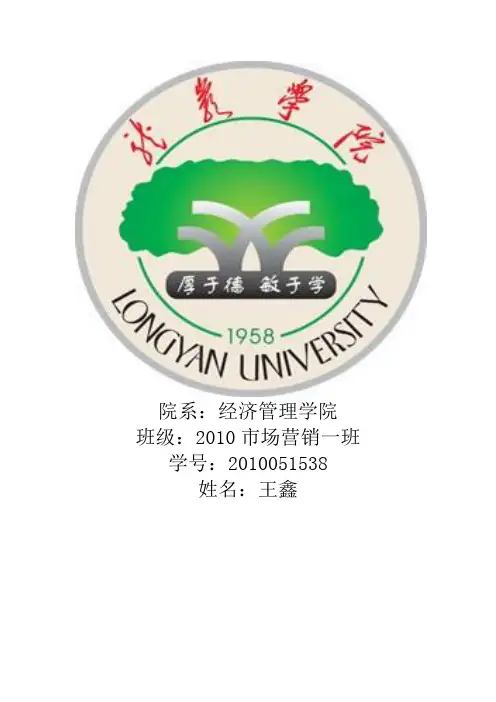
院系:经济管理学院班级:2010市场营销一班学号:2010051538姓名:王鑫Australia is a country in the southern hemisphere(南半球). It lies in most area of Oceanic. Australia is the largest country in the southern part of the Earth, the sixth largest country in the world. land area: 7,692,000 square kilometers, half larger than the whole of Western Europe. Population: 22.5 million (June 2011). The capital of Australia is Canberra. Sydney is the biggest city in the country. The official language in Australia is English.It is large country with very small population. Most of the country is covered with grassland and desert. There are a lot of wild animals living there, like kangaroos(袋鼠)and koalas(考拉). 澳大利亚是一个国家在南半球。
它坐落在最大的海洋上。
澳大利亚是世界上南半球最大的国家,是世界上国土面积第六的国家。
土地面积:7692000平方公里,比整个西欧大一半。
人口:2250万(2011年6月)。
澳大利亚的首都是堪培拉。
悉尼是全国最大的城市。
澳大利亚的官方语言是英语。
它的国土很大但人口数量却很少。

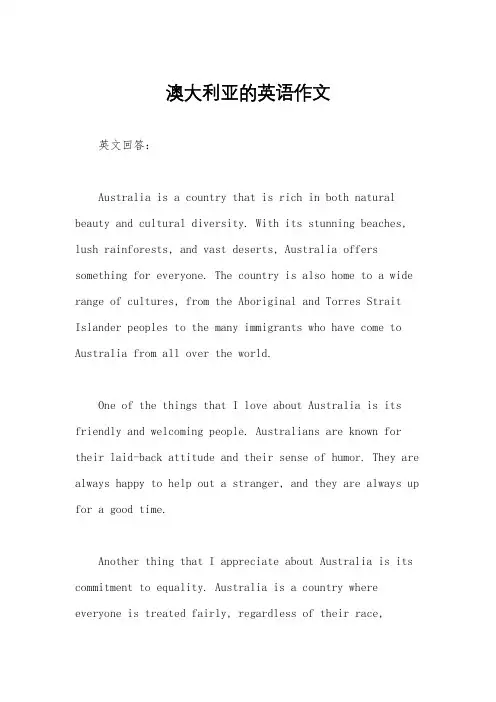
澳大利亚的英语作文英文回答:Australia is a country that is rich in both natural beauty and cultural diversity. With its stunning beaches, lush rainforests, and vast deserts, Australia offers something for everyone. The country is also home to a wide range of cultures, from the Aboriginal and Torres Strait Islander peoples to the many immigrants who have come to Australia from all over the world.One of the things that I love about Australia is its friendly and welcoming people. Australians are known for their laid-back attitude and their sense of humor. They are always happy to help out a stranger, and they are always up for a good time.Another thing that I appreciate about Australia is its commitment to equality. Australia is a country where everyone is treated fairly, regardless of their race,religion, or sexual orientation. This is reflected in the country's laws and policies, as well as in the attitudes of its people.Of course, no country is perfect, and Australia is no exception. There are still some challenges that the country faces, such as the gap between Indigenous and non-Indigenous Australians. However, I believe that Australiais a country that is on the right track. It is a country that is committed to its values of equality, diversity, and fairness.中文回答:澳大利亚是一个自然风光秀丽、文化多元的国家。
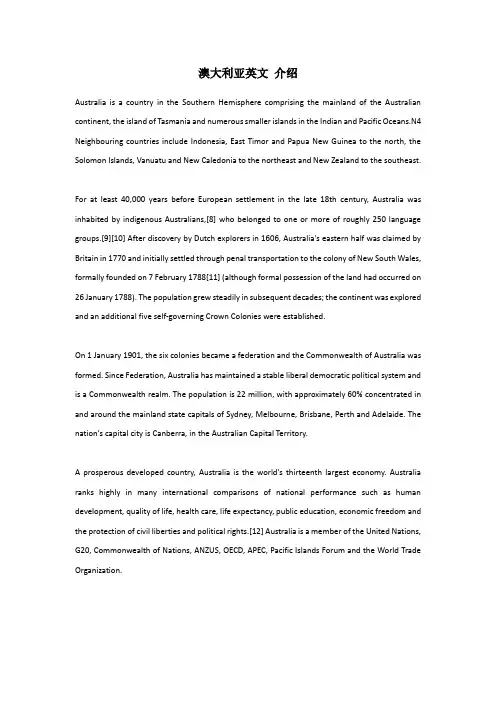
澳大利亚英文介绍Australia is a country in the Southern Hemisphere comprising the mainland of the Australian continent, the island of Tasmania and numerous smaller islands in the Indian and Pacific Oceans.N4 Neighbouring countries include Indonesia, East Timor and Papua New Guinea to the north, the Solomon Islands, Vanuatu and New Caledonia to the northeast and New Zealand to the southeast.For at least 40,000 years before European settlement in the late 18th century, Australia was inhabited by indigenous Australians,[8] who belonged to one or more of roughly 250 language groups.[9][10] After discovery by Dutch explorers in 1606, Australia's eastern half was claimed by Britain in 1770 and initially settled through penal transportation to the colony of New South Wales, formally founded on 7 February 1788[11] (although formal possession of the land had occurred on 26 January 1788). The population grew steadily in subsequent decades; the continent was explored and an additional five self-governing Crown Colonies were established.On 1 January 1901, the six colonies became a federation and the Commonwealth of Australia was formed. Since Federation, Australia has maintained a stable liberal democratic political system and is a Commonwealth realm. The population is 22 million, with approximately 60% concentrated in and around the mainland state capitals of Sydney, Melbourne, Brisbane, Perth and Adelaide. The nation's capital city is Canberra, in the Australian Capital Territory.A prosperous developed country, Australia is the world's thirteenth largest economy. Australia ranks highly in many international comparisons of national performance such as human development, quality of life, health care, life expectancy, public education, economic freedom and the protection of civil liberties and political rights.[12] Australia is a member of the United Nations, G20, Commonwealth of Nations, ANZUS, OECD, APEC, Pacific Islands Forum and the World Trade Organization.。
澳大利亚旅游介绍英文Australia is a country and continent located in the Southern Hemisphere, known for its diverse landscapes, vibrant cities, and unique wildlife. Here is an introduction to some of the must-see destinations and experiences when visiting Australia.Sydney, the largest city in Australia, is a bustlingmetropolis that offers a mix of modern architecture andnatural beauty. The iconic Sydney Opera House, with its distinctive sail-like design, is a UNESCO World Heritage site and a symbol of the nation. Nearby, the Sydney Harbour Bridge provides breathtaking views of the city and the harbour. Visitors can also explore the Royal Botanic Garden, which is home to a wide variety of native plants and offers a peaceful retreat from the city's hustle and bustle.Melbourne, the cultural capital of Australia, is famous forits arts, music, and food scenes. The city's laneways arelined with street art, cafes, and boutique shops, making it a haven for those seeking a more intimate urban experience. The Great Ocean Road, a scenic drive that starts just outside Melbourne, offers stunning coastal views and leads to the Twelve Apostles, a collection of limestone stacks that rise majestically from the Southern Ocean.For those interested in Australia's indigenous culture, avisit to Uluru, also known as Ayers Rock, is a must. This massive sandstone monolith is sacred to the Anangu people andoffers a glimpse into the country's ancient history. The nearby Kata Tjuta, also known as the Olgas, is another significant site with its own unique geological formations.The Great Barrier Reef, the world's largest coral reef system, is a natural wonder that stretches over 2,300 kilometersalong the Queensland coast. Divers and snorkelers can explore the vibrant underwater world teeming with marine life, while those who prefer to stay dry can take a scenic flight to appreciate the reef's vastness.Tasmania, an island state to the south of the Australian mainland, is known for its rugged wilderness and pristine natural beauty. The Cradle Mountain-Lake St Clair National Park is a popular destination for hiking and wildlife spotting, while the Freycinet National Park offers stunning beaches and the chance to see the famous Wineglass Bay.Australia's wildlife is one of its most famous attractions, with the opportunity to see kangaroos, koalas, and wombats in their natural habitat. The Kangaroo Island is a haven for wildlife enthusiasts, offering close encounters with these iconic creatures.No trip to Australia would be complete without experiencingits beaches. From the surf culture of Bondi Beach in Sydneyto the tranquility of Whitehaven Beach in the Whitsunday Islands, there is a beach for every taste.Lastly, Australia's wine regions, such as the Barossa Valleyin South Australia and the Hunter Valley in New South Wales,offer visitors the chance to sample some of the country's finest wines and enjoy the picturesque vineyard landscapes.In conclusion, Australia is a country of contrasts, offering everything from bustling cities to serene natural landscapes. Whether you're a city lover, a nature enthusiast, or aculture seeker, Australia has something for everyone.。
关于澳大利亚的资料,英文的Australia is a country and continent and the sixth largest in the world. Located in the Indian and Pacific oceans, it is home to over 24 million people of various nationalities and cultures. A federal parliamentary constitutional monarchy, it comprises six states and several territories. Australia has a highly developed mixed economy, and is one of the wealthiest nations in the world. The capital city of Australia is Canberra, and its largest cities include Sydney, Melbourne, Brisbane, and Perth.Australia has a diverse and beautiful landscape, ranging from lush rainforest regions to rugged mountain ranges, arid deserts, and stunning beaches. It is home to unique animals, including the koala, kangaroo, emu, and wombat, among many others. The Australian culture is also unique, and includes elements of the Aboriginal, British, and other European influences.Australia is a hot spot for international tourism, with millions of visitors visiting each year. It is home to iconic attractions like the Sydney Opera House and the Great Barrier Reef. Visitors also enjoy the diverse culture, food, and wine,and the many outdoor activities available in the stunning natural environment.。
australia的介绍英语作文英文回答:Australia, the land Down Under, is a vast country witha rich history and diverse culture. Nestled in the southern hemisphere, it is the sixth largest country in the world by landmass, occupying an entire continent and numerous islands. Its geographical isolation has shaped its unique flora and fauna, making it a biodiversity hotspot and a popular destination for nature enthusiasts.Australia's history is a tapestry woven with thethreads of Indigenous cultures, European colonization, and multicultural immigration. The Aboriginal and Torres Strait Islander peoples have inhabited the land for tens of thousands of years, and their traditions, beliefs, and art continue to play a vital role in shaping Australian society. European settlement began in the late 18th century, withthe arrival of British colonists who established a penal colony at Sydney Cove. Over the following centuries,Australia became a self-governing dominion within the British Empire, and in 1901, the six colonies federated to form the Commonwealth of Australia.Today, Australia is a vibrant and prosperous nation with a population of around 26 million people. Its major cities, such as Sydney, Melbourne, Brisbane, and Perth, are cosmopolitan hubs that embrace a diverse range of cultures and lifestyles. The Australian economy is primarily driven by mining, agriculture, and tourism, with a strong focus on innovation and technology. The country is renowned for its high standards of living, comprehensive healthcare system, and world-class education institutions.Australia's natural beauty is one of its most captivating features. From the rugged Outback and the spectacular coastline to the tropical rainforests and ancient rainforests, the country offers a diverse range of landscapes that inspire awe and wonder. The Great Barrier Reef, one of the seven natural wonders of the world, is a living masterpiece of biodiversity that attracts tourists from around the globe. Australia is also home to iconicwildlife such as kangaroos, koalas, wombats, and platypuses, which are found nowhere else on Earth.In summary, Australia is a land of contrasts and anation of many faces. Its rich history, diverse culture, stunning landscapes, and unique wildlife make it a captivating destination that offers something for everyone.中文回答:澳大利亚,这个地处南半球的国家,是世界第六大国,拥有丰富的历史和多元的文化。
关于澳大利亚旅游英语介绍随着交通工具的进步,地球上的距离在缩短,国际间经济文化交往日益增多,应运而起了经久不衰的国际旅游的大潮。
小编精心收集了关于澳大利亚旅游英语介绍,供大家欣赏学习!关于澳大利亚旅游英语介绍篇1In land area, Australia is the sixth largest nation after Russia, Canada, China, the United States of America and Brazil. It has, however, a relatively small population.Australia is the only nation to govern an entire continent and its outlying islands. The mainland is the largest island and the smallest, flattest continent on Earth. It lies between 10° and 39° South latitude.The highest point on the mainland, Mount Kosciuszko, is only 2228 metres. Apart from Antarctica, Australia is the driest continent.Australia is the driest inhabited continent on earth. Its interior has one of the lowest rainfalls in the world and about three-quarters of the land is arid or semi-arid. Its fertile areas are well-watered, however, and these are used very effectively to help feed the world. Sheep and cattle graze in dry country, but care must be taken with the soil. Some grazing land became desert when the long cycles that influence rainfall in Australia turned to drought.The Australian federation consists of six States and two Territories. Most inland borders follow lines of longitude and latitude. The largest State, Western Australia, is about the same size as Western Europe.Natural environmentAustralia has a remarkable diversity of life forms seennowhere else in the world. Australian plants and animals evolved in isolation from other parts of the world. When the super-continent of Gondwanaland split up about 160 million years ago, Australia joined Antarctica and drifted towards the South Pole, where glaciers formed a barrier between it and other land masses.Over the past 45 million years, Australia has moved away from Antarctica towards the equator and become warmer and more arid. About 35 million years ago, eucalypts began to displace the dense forests of the cool, damp Tertiary era.Today Australian eucalypts account for more than half of all eucalypts found throughout the world.关于澳大利亚旅游英语介绍篇2Tourism is a pillar industry of the economy of Australia, overseas investors and developers of the Australian tourism industry development prospects for the development of an ambitious, think its development prospects are very attractive.Sydney is the birthplace of is now the largest city in Oceania, space, sunshine, freedom is the most profound impression of Sydney. There is a great way to enjoy, just a short drive from the city's hustle and bustle of the city, the beaches and forests around Sydney to keep everyone awake. Sydney's greatest assets is its natural environment and climate, North Water and Mg Alex Bailey River, around the southern...City of plants and other Haikou. And Gold Coast and the destruction of the bushes to add it to the beautiful. No doubt, this is a city full of vitality, its charm glittering, is very easy to understand, like, even to fall in love with it, here may not be the earth on the most suitable place to live, but it is safe, clean, no pollution, although it is not a multi racial Utopia, but long before the White Australia policy was abolished, the society fullintegration of the all race and nationality of the people, in Sydney everywhere Asian faces, and you are also likely to inadvertently heard people use Greek, Japanese or Hungarian to talk. Sydney is a perfect city, Australians are very lucky, is the fate of them on this brave and beautiful scour the beach.旅游业是澳大利亚经济的一大支柱产业,海外投资者和发展商对澳大利亚旅游房产度假产业发展前景雄心勃勃,认为其开发前景非常诱人。
澳大利亚英文介绍---------------------------------------澳大利亚英文介绍AustraliaAustralia is a island country .It is located in Oceania between the Indian Ocean and the South Ocean.The Australian Aborigines’arrival is the binging of Australia about 50 000 years ago.European countries did not know whether there was a continent ,Australia ,before 1768.So they drew a hypothetical map, in which there was a Terra Australia .In 1768,James Cook traveled Cape Horn of South American .He continued his travel toward west .He got to New Zealand .Then he found Australia at west. When the earth and human society appeared was called the Dreamtime.During the Dreamtime, the Rainbow Serpent made laws: people can not eat his animal totem .Bushranging means thieving from law-abiding citizens while living in the Australia Outback.There are two different places we should attention .One is the Cape Hornin South American, the other is the Cape of Good Hope in Africa.Some people moved from Botany Bay to Jackson Port. They founded the city of Sydney, Jackson Port, Sydney Cove . In 1901,the colonies of Australia federated into a country . Australia Day is celebrated annually in January 26. There are some famous states and countries in Australia .Canberra is the capital of Australia. Sydney is the capital of New South Wales. Melbourne is the capital of Victoria .There are some states such as Queensland, Tasmania .There are two famous builds, Sydney Opera House and Sydney Harbor Bridge.There are many animals in Australia , kangaroo and thylacine called marsupial animal ,ostrich and emu .How did people catch flying animals? They used boomerang . They also like music performed by didgeridoo .There is a famous song about Australia named Waltzing Matilda:Once a jolly swagman camped by a billabongUnder the shade of a coolabah treeAnd he sang as he watched and waited till his billy boiled“Who will come a - Waltzing Matilda,with me ?”Waltzing Matilda, Waltzing MatildaYou will come a - Waltzing Matilda,with meAnd he sang as he watched and waited till his billy boiled“You will come a - Waltzing Matilda,with me”Down came a jumbuck to drink at that billabongUp jumped the swagman and grabbed him with gleeAnd he san g as he shoved that jumbuck in his tucker bag: “You will come a -Waltzing Matilda,with me”Waltzing Matilda, Waltzing Matilda“You will come a - Waltzing Matilda,with me”And he sang as he shoved that jumbuck in his tucker bag: “You will come a -Waltzing Matilda,with me”Up rode the squatter mounted on his thoroughbred Down came thetroopers ,one,two,and three.“Whose is that jumbuck you have got in your tucker bag? You will come a - Waltzing Matilda,with me”Waltzing Matilda, Waltzing Matilda“You will come a - Waltzing Matilda,with me”“Whose is that jumbuck you have got in your tucker bag? You will come a - Waltzing Matilda,withme”Up jumped the swagman and sprang into the billabong “You wil l never take me alive!”said heAnd his ghost may be heard as you pass by that billabong: “Who will come a -Waltzing Matilda,with me ?”Waltzing Matilda, Waltzing Matilda“You will come a - Waltzing Matilda,with me”And his ghost may be hea rd as you pass by that billabong: “Who will come a -Waltzing Matilda,with me ?”感谢阅读,欢迎大家下载使用!。
关于澳大利亚的英文介绍Australia: An introductionIn land area, Australia is the sixth largest nation after Russia, Canada, China, the United States of America and Brazil. It has, however, a relatively small population.Australia is the only nation to govern an entire continent and its outlying islands. The mainland is the largest island and the smallest, flattest continent on Earth. It lies between 10° and 39°South latitude.The highest point on the mainland, Mount Kosciuszko, is only 2228 metres. Apart from Antarctica, Australia is the driest continent.Australia is the driest inhabited continent on earth. Its interior has one of the lowest rainfalls in the world and about three-quarters of the land is arid or semi-arid. Its fertile areas arewell-watered, however, and these are used very effectively to help feed the world. Sheep and cattle graze in dry country, but care must be taken with the soil. Some grazing land became desert when the long cycles that influence rainfall in Australia turned to drought.The Australian federation consists of six States and two Territories. Most inland borders follow lines of longitude and latitude. The largest State,Western Australia, is about the same size as Western Europe.Natural environmentAustralia has a remarkable diversity of life forms seen nowhere else in the world. Australian plants and animals evolved in isolation from other parts of the world. When the super-continent of Gondwanaland split up about 160 million years ago, Australia joined Antarctica and drifted towards the South Pole, where glaciers formed a barrier between it and other land masses.Over the past 45 million years, Australia has moved away from Antarctica towards the equator and become warmer and more arid. About 35 million years ago, eucalypts began to displace the dense forests of the cool, damp Tertiary era.Today Australian eucalypts account for more than half of all eucalypts found throughout the world. The marsupials native to Australia have a different chromosome structure than mammals in other parts of the world. Typically, they suckle their young in a pouch.Like the eucalypts, marsupials occupied a wide range of ecological niches in Australia. The first kangaroo marsupials seem to have appeared about 15 million years ago. They vary enormously in size and adaptation. A species of tropical kangaroo lives intrees, but most kangaroos are tough, efficient users of dry bush.As the world climate warmed and glaciers melted, oceans gradually rose to their current level and the land bridges to New Guinea and Tasmania were cut. Corals colonised a flooded coastal plain, forming the Great Barrier Reef of Queensland.Ancient plants still grow in the wild. Large'Antarctic' tree ferns are common in damp, shaded gullies on the south sides of ridges. Cycad palms form an understorey to tall, silvery spotted gums (eucalypts) along the south-east coast. Rare relics from earlier geological eras are found in small, special habitats, such as desert canyons. Pressure on native habitats from agriculture and introduced pests like the fox and rabbit have resulted in extinctions of some native species in the past 200 years. Australia now has a strong scientific and legal framework to deal with these issues. Australians care about their unique environment.HistoryMore than 60 000 years before the arrival of European settlers, Aboriginal and Torres Strait Islander peoples inhabited most areas of the Australian European settlement in 1788. However, there were an estimated 300 000 IndigenousAustralians living on the continent.Until recently, Western historians focused on early European contact with the Australian continent during the 16th and 17th centuries.In recent years this approach has been balanced by the recognition that Asian and Oceanic explorers and traders had contact with Indigenous Australian people long before the European expansion into the eastern hemisphere.After the American War of Independence, Britain looked to establish new penal settlements to replace the north Atlantic colonies. The First Fleet of 11 ships with 1500 aboard, half of them convicts, arrived at Botany Bay in January 1788. Sydney grew from that first British penal settlement.Transportation of British convicts to New South Wales ceased in 1840, but continued to Western Australia until 1868. About 160 000 convicts arrived over 80 years. That compares with free settler arrivals as high as 50 000 a year. During the 1850s, settlement was boosted by gold rushes. Scarcity of labour, the vastness of the bush, and new wealth based on farming, mining and trade all contributed to the development of uniquely Australian social institutions and sensibilities. In 1901 the Australian colonies federated to becomethe Commonwealth of Australia. As in Canada, the British monarch remains the monarch of Australia, which is now an independent, democratic nation with a tradition of religious tolerance and free speech. ImmigrationAustralia's culturally diverse society includes its Indigenous peoples and settlers from countries all around the world.Immigration is an important feature of Australian society. Since 1945, over six million people from 200 countries have come to Australia as new settlers. Migrants have made a major contribution to shaping modern Australia. People born overseas make up almost one quarter of the total population.The federal government sets immigration intake numbers on a yearly basis. Australia's immigration policies are non-discriminatory and all applicants to migrate must meet the same selection criteria. Area and population of Australian States and TerritoriesState/TerritoryArea in square kilometresSources: area—Auslig; population—Australian Bureau of Statistics* Estimated resident population as at 30 June 2001. EconomyAustralia has had one of the most outstandingeconomies of the world in recent years. As a high-growth, low-inflation, low interest rate economy, it is more vibrant than ever before. There is an efficient government sector, a flexible labour market and a very competitive business sector.With its abundant physical resources, Australia has enjoyed a high standard of living since the nineteenth century. It has made a comparatively large investment in social infrastructure, including education, training, health and transport.The Australian workforce has seen many improvements over the last decade, leading to the surge in productivity in the 1990s. The complex and centralised award based industrial relations system has given way to a more decentralised one with many employees working under workplace agreements tailored to meet enterprise needs. Further informationAustralian Biodiversity.auNational Library of Australia.au/oz/histsite.htmlDepartment of Immigration and Multicultural and Indigenous Affairs .auThe Australian Government Treasury.auFurther information about other aspects of contemporary Australia。